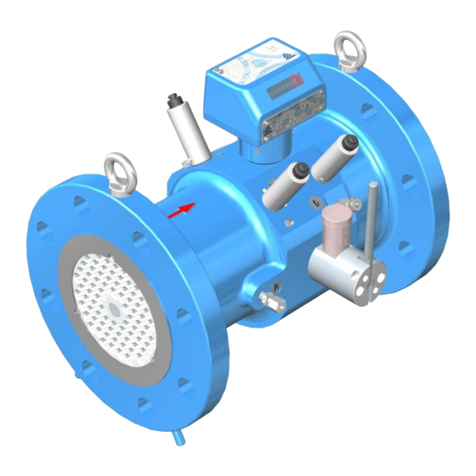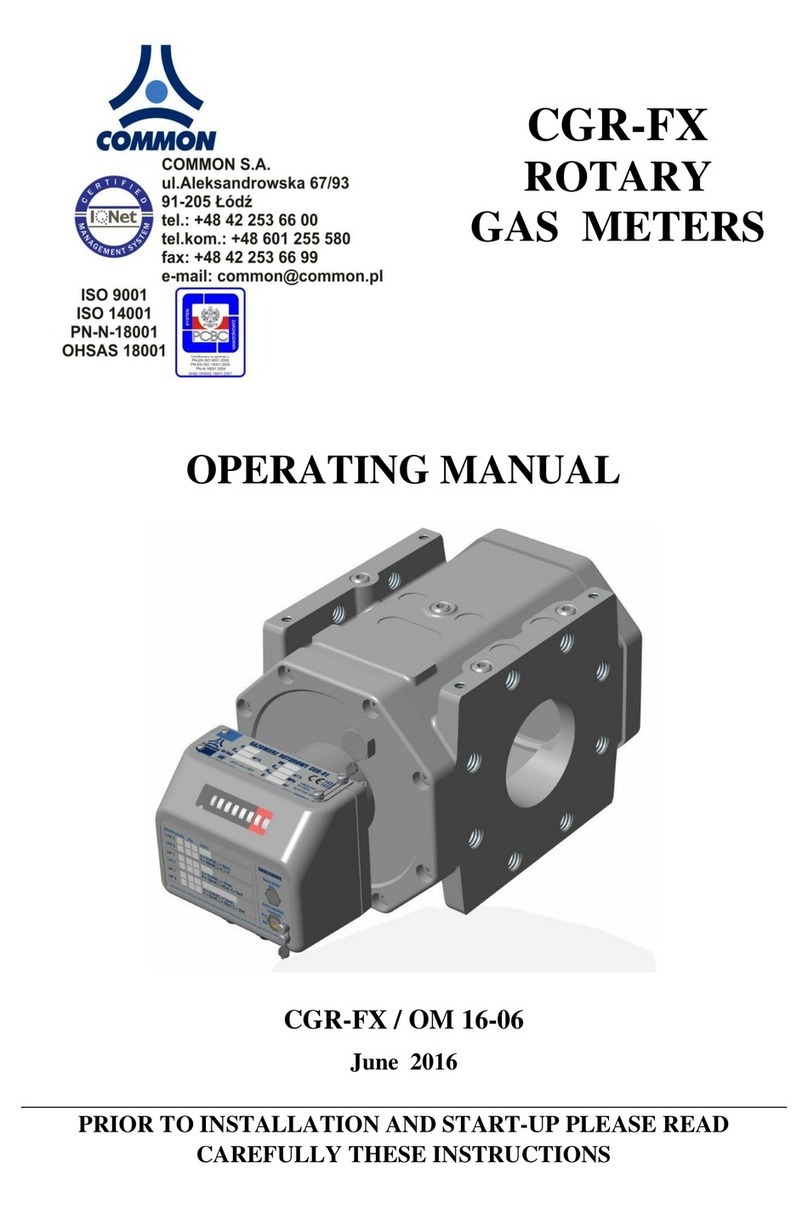
5
Table 2.
Essential metrological parameters of CGR-01 rotary gas meters.
DN
nominal
diameter
G
meter size
Q
max
maximum
flow
Q
min
minimum flow [m
3
/h ]
LF
pulser constant
HF
pulser constant
(approximately)
V
cyclic
volume
∆p
pressure loss
at Q
max
Series
[mm]
[m
3
/h]
turn down ratio (rangeability)
[pulses/m
3
] [pulses/m
3
] [dm
3
]
[Pa] [-]
1:50 1:65 1:100 1:160 1:200 1:250
40/50 G10p 16 0,3 0,25 0,16 - - - 10 15459 0,23 110 / 85 „171”
40/50 G16p 25 0,5 0,4 0,25 0,16 - - 10 15459 0,23 185 / 140 „171”
40/50 G16w 25 0,5 0,4 0,25 0,16 - - 10 11470 0,31 105 / 80 „171”
40/50 G25s 40 0,8 0,65 0,4 0,25 0,2 0,16 10 15459 0,23 375 / 280 „171”
40/50 G25p 40 0,8 0,65 0,4 0,25 0,2 0,16 10 11470 0,31 240 / 180 „171”
40/50 G25w 40 0,8 0,65 0,4 0,25 - - 10 7111 0,50 110 / 80 „171”
40/50 G40s 65 1,3 1,0 0,65 0,4 0,3 0,25 10 11470 0,31 480 / 360 „171”
40/50 G40p 65 1,3 1,0 0,65 0,4 0,3 0,25 10 7111 0,50 280 / 210 „171”
40/50 G40w 65 1,3 1,0 0,65 0,4 - - 10 4390 0,81 195 / 150 „171”
50/80 G65s 100 2,0 1,6 1,0 0,65 0,5 0,4 10 7111 0,50 420/320 „171”
50/80 G65p 100 2,0 1,6 1,0 0,65 0,5 0,4 10 4390 0,81 325/290 „171”
50/80 G65w 100 2,0 1,6 1,0 0,65 - - 10 2867 1,24 245/200 „171”
50/80 G100s 160 3,2 2,5 1,6 1,0 0,8 0,65 1 4390 0,81 570 / 430 „171”
50/80 G100p 160 3,2 2,5 1,6 1,0 0,8 0,65 1 2867 1,24 505 / 395 „171”
80/100 G100p 160 3,2 2,5 1,6 1,0 0,8 0,65 1 1654 1,29 220 / 160 „241”
80/100 G100w 160 3,2 2,5 1,6 1,0 - - 1 1067 2,00 180 / 135 „241”
80/100 G160s 250 5,0 4,0 2,5 1,6 1,3 1,0 1 1654 1,29 530 / 400 „241”
80/100 G160p 250 5,0 4,0 2,5 1,6 1,3 1,0 1 1067 2,00 370 / 280 „241”
80/100 G160w 250 5,0 4,0 2,5 1,6 - - 1 639 3,34 270 / 210 „241”
100 G250s 400 8,0 6,5 4,0 2,5 2,0 1,6 1 1067 2,00 660 „241”
100 G250p 400 8,0 6,5 4,0 2,5 2,0 1,6 1 639 3,34 510 „241”
Meter size: p – basic version,
w – low speed version (bigger sizes, lower pressure drop, lower noise level),
s – high speed version (smaller sizes, higher pressure drop, higher noise level).






























